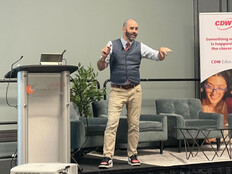How to Ready Stakeholders for Learn Now, Lecture Later
A new model of teaching has begun to push aside the traditional "sage on the stage" model, in which an educator stands at the front of the classroom reciting information to students. Today, many with a passion for education believe a teacher should function instead as a "guide on the side," empowering students to construct their own base of knowledge through active, collaborative, technology-driven learning activities.
Through this emerging model, teachers make lectures available to students to view outside of class, so that classroom time can be dedicated to hands-on learning and group projects, among other things. This idea of "learn now, lecture later" encompasses everything from flipped classrooms and blended (or hybrid) programs to distance, virtual and online learning.
The CDW•G Learn Now, Lecture Later report strives to understand how these new models are transforming today's classrooms, how technology can support the transition and what challenges schools must overcome to achieve success. Based on a spring 2012 survey of 1,015 public high school and higher education students, faculty and IT professionals, the report recommends that schools take four key steps:
- Get to the heart of what students and faculty want;
- Consider how to incorporate different learning models;
- Explore how technology can support and enhance new and emerging classroom models; and
- Support teachers and IT with professional development and infrastructure, respectively.
Moving Beyond the Lectern
The students who took part in the survey believe that the ways in which they're using their classroom time are evolving in the right direction. But they still want a greater mix of learning models. Although 53 percent of them say that their teachers use traditional lecture approaches, only 38 percent want to learn that way.
Indeed, the most satisfied students say they listen to fewer lectures and use more technology in class. And two-thirds of them report that they'd like to incorporate more technology into their learning, citing notebook and netbook computers, tablets, smartphones, digital content and recorded class lectures as preferred technologies.
Meanwhile, half of the teachers surveyed already have begun shifting away from traditional lectures, and 20 percent say they're considering such a move. Among those who have done so, group projects (64 percent) and hands-on projects (60 percent) are the most popular alternative instructional delivery methods. To facilitate further changes in their classrooms, teachers say they'd most like to have access to notebooks and netbooks, tablets and digital content.
IT professionals say an improved infrastructure is needed to support such changes. The improvements they consider most essential include adding to or upgrading server and storage capacity (51 percent), retooling wireless and networking infrastructure (49 percent), and adopting cloud computing (42 percent).
What does this mean for schools going forward? Perhaps Thomas Brenneman, executive director of technology for Kansas City (Mo.) Public Schools, says it best when he describes the benefits of his district's distance learning efforts in this issue's feature story on distance learning. "Having more choice in the types and level of courses available to students gives them a leg up on college," he says. "There's this sense of fun and reward that helps to make the classes more successful. And the teachers really get excited about their abilities to present information in different ways and to connect with the students a little bit better using technology."
Join us on April 16, 2013 for a webinar focusing on outside-the-box thinking and innovative technologies that drive schools’ successful distance learning programs. Learn more and register here.








